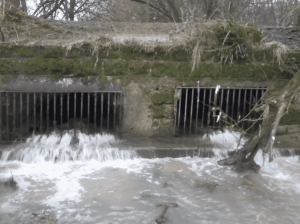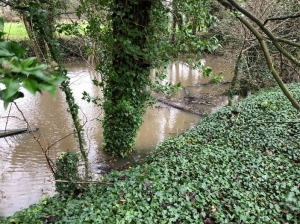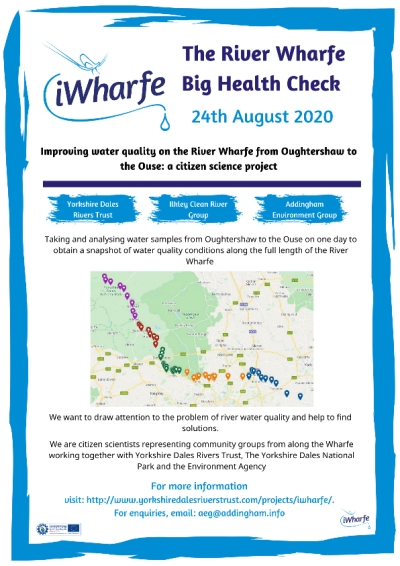The Wharfe
The River Wharfe in Addingham runs along our northern boundary. There are two impoundments on this stretch of the river, the weir at High Mill and the weir at Low Mill, both constructed to provide a head of water to power the mills before coal-fired steam boilers were introduced in the 19th century. The weirs are now redundant. Some on other Yorkshire rivers, including the Nidd and the Aire, have been removed completely in attempts to restore river habitats and enable the passage of fish. In other cases where weirs have been retained fish passes have been installed. There are now plans to construct a fish pass at Low Mill. Click here for further information.
Except for the problem of fish barriers, general water quality in the Wharfe in Addingham is very good, at least as far as Sandbeds. In wet weather untreated sewage is often discharged by Yorkshire Water from the Addingham Pumping Station into the Mill Stream at Low Mill to enter the river at the point where it begins to run alongside the Old Ilkley Road. So the stretch from there to Ilkley is frequently polluted by faecal bacteria. Further and more continuous pollution takes place in Ilkley.
We have been working closely with the Ilkley Clean River Group and Yorkshire Dales Rivers Trust on water quality issues in the Wharfe.
 The first project, the Ashlands Project, concerned the poor performance of the Ashlands Sewage Treatment Works (STW) in Ilkley and the impact of spills of untreated sewage on water quality in the river. The performance of this Works is very relevant to us in Addingham as this is where our sewage is treated. The discharge of effluent, whether treated or untreated, causes nutrient pollution (of concern for the ecological health of the river) and faecal bacteria pollution (of concern for public health, especially swimmers).
The first project, the Ashlands Project, concerned the poor performance of the Ashlands Sewage Treatment Works (STW) in Ilkley and the impact of spills of untreated sewage on water quality in the river. The performance of this Works is very relevant to us in Addingham as this is where our sewage is treated. The discharge of effluent, whether treated or untreated, causes nutrient pollution (of concern for the ecological health of the river) and faecal bacteria pollution (of concern for public health, especially swimmers).
A briefing document on these issues prepared for John Grogan, our local MP at the time, can be found here. Most of our work so far has concerned faecal bacteria pollution.
With funding from Ilkley Town Council, Wharfedale Naturalists Society and the Rivers Trust we set up our own citizen science study of the river to assess the impact of sewage effluent on the concentration of E. coli in the water. Our report to the Council from July 2019 can be found here.
We showed that the river downstream of the STW was heavily contaminated by faecal bacteria in all flow conditions, continuously from the treated (or final) effluent outfall and intermittently, but frequently from the storm overflow. We also showed that high concentrations of faecal bacteria further downstream in Burley were caused by effluent discharges from Ilkley and Ben Rhydding. The report is here.
 We compared the concentration of E. coli downstream with the concentration upstream at the Cromwheel corner in different flow conditions. In low flow, concentrations upstream were quite low, safe for swimming, but in high flow they could be quite high, indicating the presence of a significant source of faecal bacteria further upstream.
We compared the concentration of E. coli downstream with the concentration upstream at the Cromwheel corner in different flow conditions. In low flow, concentrations upstream were quite low, safe for swimming, but in high flow they could be quite high, indicating the presence of a significant source of faecal bacteria further upstream.
In 2019 in a bid to raise awareness about the problem of overflowing sewage in the river, the Ilkley Clean River Group decided to apply for Bathing Water status for the stretch of river from the New Brook St. Bridge down to Beanlands Island. We consequently turned our attention to identifying the sources of faecal bacteria arriving in Ilkley from upstream sources including the Addingham Pumping Station and Addingham becks. Our report for December 2019 can be found here.
The results showed that after heavy rainfall events the Addingham Pumping Station becomes overwhelmed and untreated effluent is discharged into the Mill Stream at Low Mill and thence into the Wharfe. Click here for details. Although the volume of relatively clean water in the river provides considerable dilution the concentration of faecal bacteria in the effluent is sufficiently high to cause unsafe conditions at the designated bathing site in Ilkley.
A further study in 2021 showed that in certain weather conditions, specifically when heavy rainfall follows a long period of dry weather, high concentrations of faecal bacteria can be washed into tributary becks and the main river from agricultural land as reported here.
In 2020, we launched the iWharfe Project designed as a citizen science project not only to take samples from sites on the river close to Ilkley but to take samples along the full length of the river from Oughtershaw in Upper Wharfedale to Cawood at the junction of the Wharfe and the Ouse south of York.
It involved the Ilkley Clean River Group, Yorkshire Dales Rivers Trust (YDRT), Addingham Environment Group, Dales to Vale River Network and the Environment Agency together with charities and other community groups from along Wharfedale working together. We called it the “The Big Health Check”. It took place on Monday, 24th August, 2020 involving five teams sampling at 60 sites along the river more or less simultaneously on the same day. Samples were analysed for both faecal bacteria and for nutrient chemistry. Results from the faecal bacteria survey can be seen here.
Results from the nutrient chemistry survey, together with diatom data, can be seen here.
Some of the aspects of the 2020 faecal bacteria survey were repeated in 2021, as reported here.


